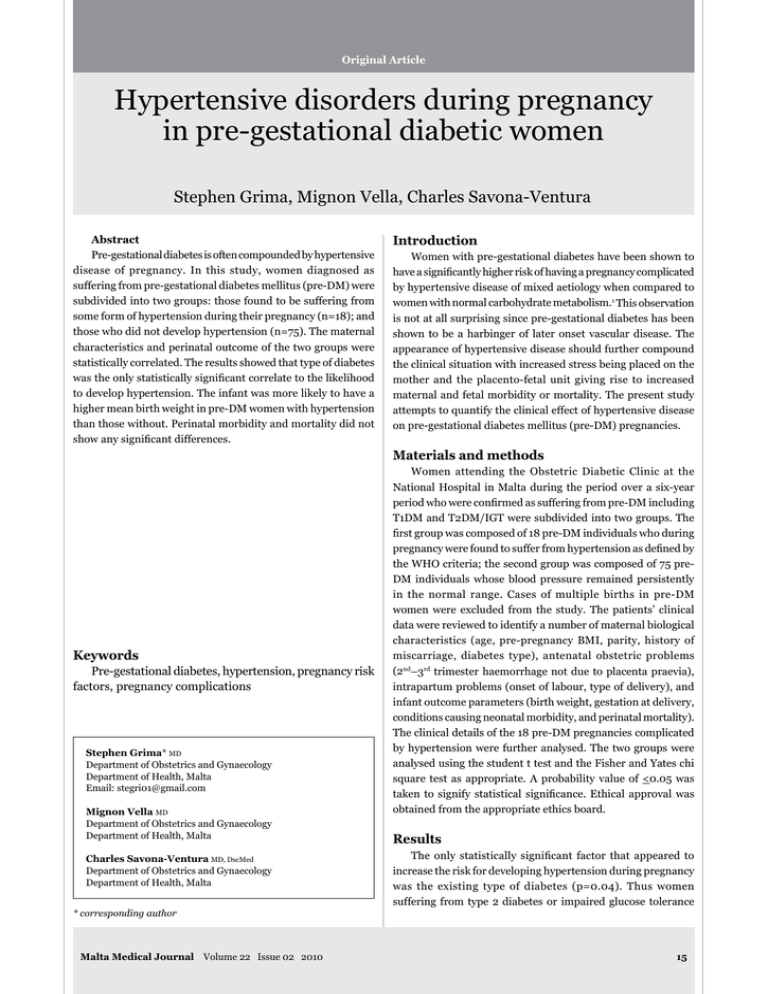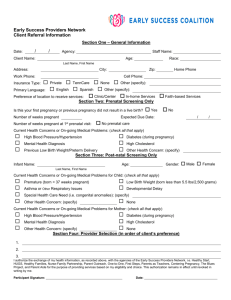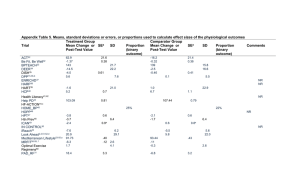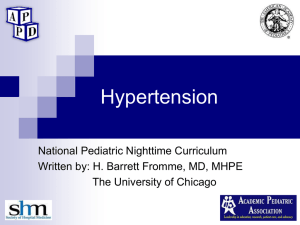Hypertensive disorders during pregnancy in pre-gestational diabetic women Introduction
advertisement

Original Article Hypertensive disorders during pregnancy in pre-gestational diabetic women Stephen Grima, Mignon Vella, Charles Savona-Ventura Abstract Pre-gestational diabetes is often compounded by hypertensive disease of pregnancy. In this study, women diagnosed as suffering from pre-gestational diabetes mellitus (pre-DM) were subdivided into two groups: those found to be suffering from some form of hypertension during their pregnancy (n=18); and those who did not develop hypertension (n=75). The maternal characteristics and perinatal outcome of the two groups were statistically correlated. The results showed that type of diabetes was the only statistically significant correlate to the likelihood to develop hypertension. The infant was more likely to have a higher mean birth weight in pre-DM women with hypertension than those without. Perinatal morbidity and mortality did not show any significant differences. Introduction Women with pre-gestational diabetes have been shown to have a significantly higher risk of having a pregnancy complicated by hypertensive disease of mixed aetiology when compared to women with normal carbohydrate metabolism.1 This observation is not at all surprising since pre-gestational diabetes has been shown to be a harbinger of later onset vascular disease. The appearance of hypertensive disease should further compound the clinical situation with increased stress being placed on the mother and the placento-fetal unit giving rise to increased maternal and fetal morbidity or mortality. The present study attempts to quantify the clinical effect of hypertensive disease on pre-gestational diabetes mellitus (pre-DM) pregnancies. Materials and methods Keywords Pre-gestational diabetes, hypertension, pregnancy risk factors, pregnancy complications Stephen Grima* MD Department of Obstetrics and Gynaecology Department of Health, Malta Email: stegri01@gmail.com Mignon Vella MD Department of Obstetrics and Gynaecology Department of Health, Malta Charles Savona-Ventura MD, DscMed Department of Obstetrics and Gynaecology Department of Health, Malta * corresponding author Malta Medical Journal Volume 22 Issue 02 2010 Women attending the Obstetric Diabetic Clinic at the National Hospital in Malta during the period over a six-year period who were confirmed as suffering from pre-DM including T1DM and T2DM/IGT were subdivided into two groups. The first group was composed of 18 pre-DM individuals who during pregnancy were found to suffer from hypertension as defined by the WHO criteria; the second group was composed of 75 preDM individuals whose blood pressure remained persistently in the normal range. Cases of multiple births in pre-DM women were excluded from the study. The patients’ clinical data were reviewed to identify a number of maternal biological characteristics (age, pre-pregnancy BMI, parity, history of miscarriage, diabetes type), antenatal obstetric problems (2nd–3rd trimester haemorrhage not due to placenta praevia), intrapartum problems (onset of labour, type of delivery), and infant outcome parameters (birth weight, gestation at delivery, conditions causing neonatal morbidity, and perinatal mortality). The clinical details of the 18 pre-DM pregnancies complicated by hypertension were further analysed. The two groups were analysed using the student t test and the Fisher and Yates chi square test as appropriate. A probability value of <0.05 was taken to signify statistical significance. Ethical approval was obtained from the appropriate ethics board. Results The only statistically significant factor that appeared to increase the risk for developing hypertension during pregnancy was the existing type of diabetes (p=0.04). Thus women suffering from type 2 diabetes or impaired glucose tolerance 15 Table 1: Maternal characteristics and complications Maternal characteristics and complications Hypertensive N = 18 Non-hypertensive N = 75 p value 30.89 ± 5.38 29.40 ± 5.73 0.32 86.7% 13.3% 0.27 28.46 ± 5.97 0.24 Maternal age in years (mean ± sd) ≤35 years >35 years 14 4 Maternal BMI (mean ± sd) 77.8% 22.2% 65 10 30.23 ± 3.89 Parity 0 1-2 3+ 10 7 1 55.6% 38.9% 5.5% 38 32 5 50.7% 42.7% 6.7% 0.43 Miscarriages 0 1 2+ 13 3 2 72.2% 16.7% 11.1% 58 11 6 77.3% 14.7% 8.0% 0.43 0 - 0 - Type of diabetic condition T1DM (IDDM) IGT/T2DM (NIDDM) 9 9 50.0% 50.0% 58 17 77.3% 22.7% 0.04 Planned delivery by Induction Elective LSCS 4 6 22.2% 33.3% 25 31 33.3% 41.3% 0.19 13 72.2% 50 66.7% 0.62 2nd–3rd trimester haemorrhage not due to placenta praevia Caesarean section delivery had a 2.6-fold greater predisposition to develop hypertension (34.6%) when compared to women suffering from type 1 diabetes (13.4%). Women suffering from pre-DM also appeared to be more likely to develop hypertensive disease if they were aged more than 35 years, obese, and primiparous or giving a history of previous miscarriages. However, none of these characteristics showed any statistical significance (Table 1). The development of hypertension in pre-gestational women was apparently not associated with a higher rate in obstetric intervention as evident by planned deliveries through elective Caesarean section or induction of labour (55.5% in pre-DM + BP vs 74.6% in pre-DM – BP; p=0.28). The Caesarean delivery rate appeared to be non-statistically significant higher in those pre-DM women with hypertension (72.2% vs 66.7%; p=0.87) (Table 1). The diastolic blood pressure of those patients with diabetes was generally controlled with pharmacological treatment so that only two cases had a reading greater than 100 mmHg. The majority (12 cases) were complicated by mild proteinuria. 16 Only two cases had a significant proteinuria. The latter also had uric acid levels above 350 µmol/l. Platelet counts were always within normal limits. The mean blood urea in the cases was 4.3 + 1.1 mmol/l with only three cases having a maximum values greater than 5.5 mmol/l; while the serum creatinine was 69.2 + 20.4 μmol/l with only one case having a value greater than 110 μmol/l (value = 134 μmol/l). Infants born to pre-DM women with hypertension appeared to be significantly (p=0.02) associated with a tendency towards higher mean birth weight (3753.61 + 735.39g) when compared to infants born to pre-DM women without hypertension (3304.44 + 711.83g). The tendency towards larger mean infant birth weights was evident in both pre-Type 1 and pre-Type 2 diabetic mothers. This relatively higher birth weight appears to be related in part to an increase in the macrosomia rate and a decrease in low birth weight infants in the hypertensive group (Table 2); and to the apparent increase of delivery of premature infants at 34 weeks gestation or less in the non-hypertensive group. Other perinatal outcome parameters were not significantly different in both groups (Table 2/Figure 1). Malta Medical Journal Volume 22 Issue 02 2010 Birth weight (gms) Figure 1: Infant birth weight in presence of hypertension with standard 5% & 95% centile birth weight by gestation values Gestation (weeks) Discussion The prevalence of pre-DM would be expected to be similar to that reported in the reproductive age female population. The prevalence of previously-diagnosed diabetes mellitus and impaired glucose tolerance in the Maltese reproductive age female population had been estimated by epidemiological studies in the early 1980s to be 0.5%.2 The prevalence of pregestational diabetes had been estimated at 0.35%; a rate similar to the one reported in the general non-pregnant population especially considering that the relative age distribution tends to favour a younger population in the pregnancy group.1,3 The prevalence of hypertension in the non-pregnant Maltese female population of reproductive age in the early 1980s was estimated at 5.9%.2 The rate of hypertensive disease in pregnancy was during the same period reported as 6.8% 4, a figure that has been approximately maintained in the period 2000-2004.5 Maltese women with pre-gestational diabetes have been reported as having a greater incidence of hypertensive disease reaching a rate of about 27.3%.1 The apparent association between hypertensive disease and pre-DM suggests that there might be an inter-relationship between these two conditions. The present study has shown that about a third (34.6%) of women suffering from type 2 diabetes and impaired glucose tolerance develop hypertension during their pregnancy. Type 2 DM and IGT form part of the complex metabolic syndrome which is associated with the eventual development of hypertension; and hence the development of gestational hypertension in these women reflects an underlying tendency to develop essential hypertension later on in life which is brought out by the cardiovascular stresses brought on by the pregnancy state. A lesser proportion (13.4%) of Type 1 DM women develops hypertension during pregnancy; this rate however is still much greater than that reported in the nondiabetic population (5.9%) suggesting the Type 1 DM woman in the reproductive age group may have already developed a degree of vascular disease. Hypertensive diseases of pregnancy are the most common serious medical disorders seen by obstetricians.6 These diseases Table 2: Infant characteristics and complications Infant characteristics and complications Hypertensive n = 18 Non-hypertensive n = 75 p value Birth weight in g (mean ± sd) 3753.61 ± 735.39 3304.44 ± 711.83 0.02 T1DM T2DM 3555.56 ± 864.17 3951.67 ± 560.49 3356.71 ± 705.14 3126.12 ± 726.93 <2500g 2500-3999g >=4000g 0 12 6 66.7% 33.3% 8 51 16 10.7% 68.0% 21.3% 0.22 Prematurity <=34 weeks 35-36 weeks 1 4 5.6% 22.4% 7 10 9.3% 13.3% 0.43 Apgar score 1-7 at 5 min 1 5.6% 3 4.0% 0.58 Respiratory distress syndrome 4 22.4% 12 16.0% 0.37 Shoulder dystocia 0 - 1 1.3% 0.82 Postnatal seizures 0 - 0 - Perinatal mortality (all stillbirths) 0 - 3 4.0% Malta Medical Journal Volume 22 Issue 02 2010 0.52 17 constitute a range of disorders with different aetiologies and pathology. They are generally classified into clinical categories without reference to aetiology. Broadly, they may be sub-divided into pre-existing conditions, pre-eclampsia syndrome, and gestational hypertension. The latter group includes a mixture of patients who either develop pre-eclampsia syndrome without proteinuria or have a latent underlying essential hypertension possibly with a mild degree of renal impairment which becomes evident during pregnancy.7 All the hypertensive disorders have long been associated with higher rates of maternal and fetal mortality and morbidity;7 however the pre-eclampsia syndrome gives a greater contribution towards adverse events. No attempt has been made in the present study to differentiate between the various categories of hypertension, but the majority appear to be either cases of pre-existing or gestational hypertension possibly with a degree of diabetic renal involvement. Only two cases had significant proteinuria with elevated uric acid levels. Since placental insufficiency with its adverse effects on fetal development is more likely to occur with pre-eclampsia syndrome rather than with gestational hypertension, the preponderance of the latter form of hypertension would explain why the present study failed to demonstrate any particular increase in morbidity. Since the development of hypertension reflects a more severe form of diabetes, it is not surprising that the mean birth weight of infants born to hypertensive pre-DM mothers appeared to have a larger mean birth weight. A similar inter-relationship of elevated birth weights with hypertensive disease has been observed in gestational diabetes. 8 The present study has failed to demonstrate definite statistically significant adverse perinatal outcomes in the hypertensive group of patients though higher non-statistiacally significant rates were observed for mode of delivery and risks of prematurity. The lack of observed statistical significance could in part be the result of the small population number included in the study, which however included all the pre-gestational diabetic patients who delivered in the Maltese islands during the period of the study. 18 Conclusions Pre-gestational diabetes appears to have a greater risk of being complicated with hypertensive disease; an observation that is probably related to the known association between essential hypertension and type 2 diabetes mellitus outside pregnancy. The most likely underlying pathophysiology is the development of hypertension which is still latent but which exhibits itself in the face of the physiological stresses caused by pregnancy and the increased clinical surveillance pregnant women undergo. While the perinatal morbidity in hypertensive pre-DM women does not appear to be significantly affected when compared to non-hypertensive ones, strict antenatal vigilance of pre-DM women remains essential since the perinatal morbidity is only kept at a low level by timely intervention. References 1. Savona-Ventura C, Ellul A, Chircop M. The outcome of diabetic pregnancies in Malta. Inter J Gynecol Obstet. 2003,82:217-8. 2. Katona G, Aganovic I, Vuskan V, Skrabalo Z. The National Diabetes Programme in Malta - Final report Phases I & II. WHO. NCD/OND/DIAB/83.2. WHO, Geneva, 1983. 3. Savona-Ventura C, Chircop M, Ellul A, Azzopardi J, Janulova, L. Diabetic Pregnancy outcome in Malta. The outcome of nongestational diabetic pregnancies in the Maltese Islands. MMJ. 2004, 16(1):27-30. 4. Savona-Ventura C, Micallef I, Grech ES. Trends in maternal mortality and morbidity in the Maltese Islands. Proc.:E.S.S.A.R. Vth Annual meeting, Malta, September 1987. Government Press, Malta, 1988, p.109-18. 5. Janulova l. National Obstetric Information System (NOIS), Malta, Annual Report 2000-2004. DHI, Malta, 2001-2005 (annual publications – available at http://www.sahha.gov.mt/pages. aspx?page=121). 6. Savona-Ventura C, Buttigieg GG, Grima S. Outcomes of hypertensive obstetric patients in the Maltese Islands. Inter J Gynaecol Obstet, 2008,101:189-91. 7. WHO Study Group. The hypertensive disorders of pregnancy. Technical Report Series 758, WHO, Geneva, 1987. 8. Savona-Ventura C, Grima S. Hypertensive disorders during pregnancy in gestational diabetic women. Exp Clin Endocrinol Diabetes. 2008,116:1-4. Malta Medical Journal Volume 22 Issue 02 2010






